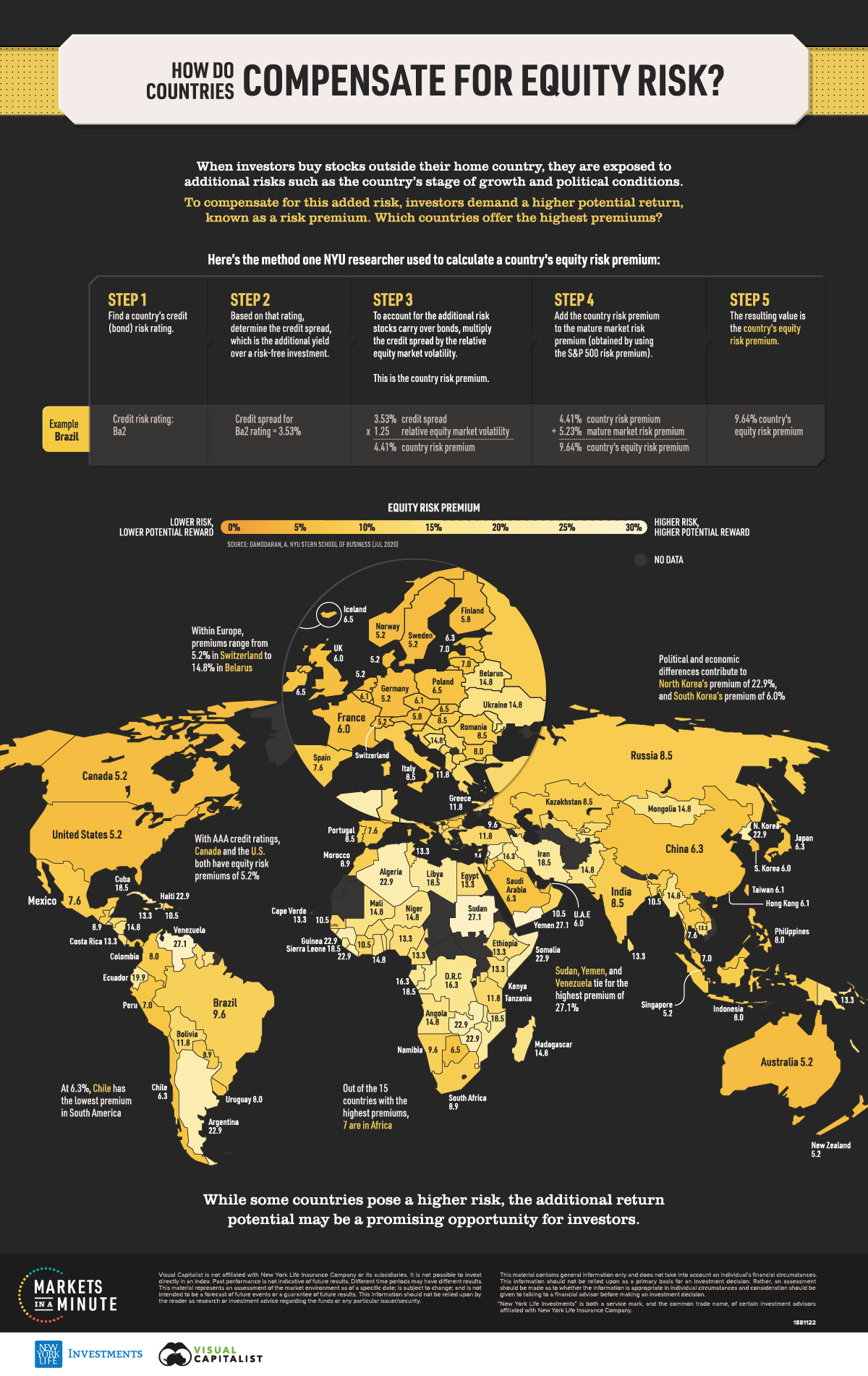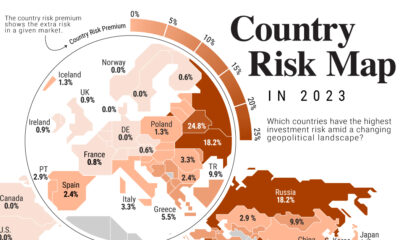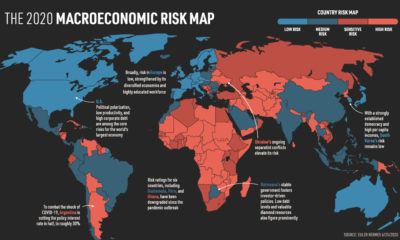How Do Countries Compensate Investors for Equity Risk?
When investors purchase stocks internationally, they are exposed to additional risks. Companies may have higher volatility based on a country’s economic, political, and legal conditions. In exchange for taking on the additional risk, investors demand a higher return potential, known as an equity risk premium.
Which countries have the highest premiums? In this Markets in a Minute from New York Life Investments, we explore equity risk premiums for countries around the world.
Behind the Numbers
The premiums are based on a study by a New York University researcher, Aswath Damodaran. All data is as of July 1, 2020.
Here are the steps Damodaran took to determine a country’s equity risk premium:
| Step | Example - Brazil |
| 1. Find a country’s credit (bond) risk rating. | Credit risk rating: Ba2 |
| 2. Based on that rating, determine the credit spread, which is the additional yield over a risk-free investment. | Credit spread for Ba2 rating = 3.53% |
3. To account for the additional risk stocks carry over bonds, multiply the credit spread by the relative equity market volatility.
This is the country risk premium. | 3.53% credit spread x 1.25 relative equity market volatility
= 4.41% country risk premium |
| 4. Add the country risk premium to the mature market risk premium (obtained by using the S&P 500 risk premium). | 4.41% country risk premium + 5.23% mature market risk premium |
| 5. The resulting value is the country equity risk premium. | 9.64% country equity risk premium |
Premiums will shift over time as a country’s credit rating, credit spread, and equity market volatility changes.
Equity Risk Premiums by Country
Below, we look at how equity risk premiums break down for 177 countries and regions, organized from highest to lowest.
| Country | Equity Risk Premium |
| Sudan | 27.14% |
| Venezuela | 27.14% |
| Yemen, Republic | 27.14% |
| Algeria | 22.86% |
| Argentina | 22.86% |
| Guinea | 22.86% |
| Haiti | 22.86% |
| Korea, D.P.R. | 22.86% |
| Lebanon | 22.86% |
| Liberia | 22.86% |
| Somalia | 22.86% |
| Syria | 22.86% |
| Zambia | 22.86% |
| Zimbabwe | 22.86% |
| Ecuador | 19.92% |
| Congo (Republic of) | 18.46% |
| Cuba | 18.46% |
| Iran | 18.46% |
| Libya | 18.46% |
| Malawi | 18.46% |
| Mozambique | 18.46% |
| Sierra Leone | 18.46% |
| Barbados | 16.25% |
| Belize | 16.25% |
| Congo (Democratic Republic of) | 16.25% |
| Gabon | 16.25% |
| Guinea-Bissau | 16.25% |
| Iraq | 16.25% |
| Angola | 14.79% |
| Belarus | 14.79% |
| Bosnia and Herzegovina | 14.79% |
| El Salvador | 14.79% |
| Gambia | 14.79% |
| Ghana | 14.79% |
| Madagascar | 14.79% |
| Maldives | 14.79% |
| Mali | 14.79% |
| Moldova | 14.79% |
| Mongolia | 14.79% |
| Myanmar | 14.79% |
| Nicaragua | 14.79% |
| Niger | 14.79% |
| Pakistan | 14.79% |
| Solomon Islands | 14.79% |
| St. Vincent & the Grenadines | 14.79% |
| Suriname | 14.79% |
| Tajikistan | 14.79% |
| Togo | 14.79% |
| Ukraine | 14.79% |
| Bahrain | 13.32% |
| Benin | 13.32% |
| Burkina Faso | 13.32% |
| Cambodia | 13.32% |
| Cameroon | 13.32% |
| Cape Verde | 13.32% |
| Costa Rica | 13.32% |
| Egypt | 13.32% |
| Ethiopia | 13.32% |
| Guyana | 13.32% |
| Jamaica | 13.32% |
| Kenya | 13.32% |
| Kyrgyzstan | 13.32% |
| Nigeria | 13.32% |
| Papua New Guinea | 13.32% |
| Rwanda | 13.32% |
| Sri Lanka | 13.32% |
| Swaziland | 13.32% |
| Tunisia | 13.32% |
| Uganda | 13.32% |
| Albania | 11.84% |
| Bolivia | 11.84% |
| Cook Islands | 11.84% |
| Greece | 11.84% |
| Honduras | 11.84% |
| Jordan | 11.84% |
| Montenegro | 11.84% |
| Tanzania | 11.84% |
| Turkey | 11.84% |
| Uzbekistan | 11.84% |
| Armenia | 10.52% |
| Bangladesh | 10.52% |
| Côte d'Ivoire | 10.52% |
| Dominican Republic | 10.52% |
| Fiji | 10.52% |
| Macedonia | 10.52% |
| Oman | 10.52% |
| Senegal | 10.52% |
| Serbia | 10.52% |
| Vietnam | 10.52% |
| Azerbaijan | 9.64% |
| Bahamas | 9.64% |
| Brazil | 9.64% |
| Croatia | 9.64% |
| Cyprus | 9.64% |
| Georgia | 9.64% |
| Namibia | 9.64% |
| Guatemala | 8.90% |
| Morocco | 8.90% |
| Paraguay | 8.90% |
| South Africa | 8.90% |
| Trinidad and Tobago | 8.90% |
| Hungary | 8.46% |
| India | 8.46% |
| Italy | 8.46% |
| Kazakhstan | 8.46% |
| Montserrat | 8.46% |
| Portugal | 8.46% |
| Romania | 8.46% |
| Russia | 8.46% |
| St. Maarten | 8.46% |
| Andorra (Principality of) | 8.03% |
| Bulgaria | 8.03% |
| Colombia | 8.03% |
| Curacao | 8.03% |
| Indonesia | 8.03% |
| Philippines | 8.03% |
| Sharjah | 8.03% |
| Uruguay | 8.03% |
| Aruba | 7.58% |
| Mauritius | 7.58% |
| Mexico | 7.58% |
| Panama | 7.58% |
| Slovenia | 7.58% |
| Spain | 7.58% |
| Thailand | 7.58% |
| Turks and Caicos Islands | 7.58% |
| Laos | 6.99% |
| Latvia | 6.99% |
| Lithuania | 6.99% |
| Malaysia | 6.99% |
| Peru | 6.99% |
| Bermuda | 6.48% |
| Botswana | 6.48% |
| Brunei | 6.48% |
| Iceland | 6.48% |
| Ireland | 6.48% |
| Malta | 6.48% |
| Poland | 6.48% |
| Ras Al Khaimah (Emirate of) | 6.48% |
| Slovakia | 6.48% |
| Chile | 6.26% |
| China | 6.26% |
| Estonia | 6.26% |
| Israel | 6.26% |
| Japan | 6.26% |
| Saudi Arabia | 6.26% |
| Belgium | 6.12% |
| Cayman Islands | 6.12% |
| Czech Republic | 6.12% |
| Guernsey (States of) | 6.12% |
| Hong Kong | 6.12% |
| Jersey (States of) | 6.12% |
| Macao | 6.12% |
| Qatar | 6.12% |
| Taiwan | 6.12% |
| Abu Dhabi | 5.96% |
| France | 5.96% |
| Isle of Man | 5.96% |
| Korea | 5.96% |
| Kuwait | 5.96% |
| United Arab Emirates | 5.96% |
| United Kingdom | 5.96% |
| Austria | 5.81% |
| Finland | 5.81% |
| Australia | 5.23% |
| Canada | 5.23% |
| Denmark | 5.23% |
| Germany | 5.23% |
| Liechtenstein | 5.23% |
| Luxembourg | 5.23% |
| Netherlands | 5.23% |
| New Zealand | 5.23% |
| Norway | 5.23% |
| Singapore | 5.23% |
| Sweden | 5.23% |
| Switzerland | 5.23% |
| United States | 5.23% |
Venezuela, Sudan, and Yemen are tied for the highest equity risk premium. While Venezuela battles hyperinflation, Yemen is suffering from a humanitarian crisis and Sudan has high perceived corruption.
In the mid-range, emerging countries such as Brazil, South Africa, and India carry moderate risk. However, they may also provide investors with higher returns than can be expected in mature markets.
On the low end of the scale, countries such as the United States, Singapore, and Germany have AAA credit ratings and the lowest premium of 5.23%.
Applying Risk Premiums to Companies
How can investors determine the equity risk premiums for individual companies?
One method is to assume that all companies incorporated in a country have equal exposure to that country’s risk. However, this is a simplified approach and does not account for the fact that a company’s operations may extend into other markets.
Alternatively, investors can calculate a weighted-average premium based on the location of a company’s revenue or production. For example, a consumer products business may weigh exposure based on the location of their revenue. An oil and gas company, where true risk lies in their reserves rather than where they sell, may instead be weighted by production.
Here’s a hypothetical example for an oil & gas company that has reserves in the United States, Saudi Arabia, and Venezuela:
| Country | Production (in kboed)* | % of Total | Equity Risk Premium |
| U.S. | 60 | 20% | 5.23% |
| Saudi Arabia | 120 | 40% | 6.26% |
| Venezuela | 120 | 40% | 27.14% |
| Total | 300 | 100% | 14.41% |
* Kilobarrels of oil equivalent per day.
The weighted-average equity risk premium is 14.41%.
Importantly, even countries headquartered in mature markets have international risks if they carry out operations in other countries.
Risk Vs. Potential Reward
Every country presents varying degrees of risk based on local conditions. As investors look to diversify internationally, it’s critical to consider two factors:
- The additional risk
- The potential additional return
Equity risk premiums serve as a guide that can help investors compare country risk, and the additional return potential they should expect for tolerating that risk.




 Infographics2 years ago
Infographics2 years ago
 Markets in a Minute2 years ago
Markets in a Minute2 years ago
 Markets in a Minute2 years ago
Markets in a Minute2 years ago
 Infographics2 years ago
Infographics2 years ago
 Markets in a Minute1 year ago
Markets in a Minute1 year ago
 Markets in a Minute2 years ago
Markets in a Minute2 years ago
 Infographics1 year ago
Infographics1 year ago
 Markets in a Minute2 years ago
Markets in a Minute2 years ago












